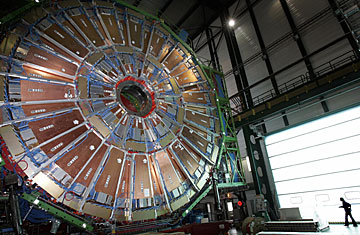
Anyone who has struggled to change a fuse in their home should pity the scientists at the CERN laboratory in Geneva. Last Friday, just nine days after celebrating the successful test run of the largest particle accelerator ever constructed, a tiny electrical connection between two magnets overheated and caused a minor meltdown.
The Large Hadron Collider (LHC) broke.
Although a final evaluation is yet to be completed, scientists believe the fault caused the machine to lose the near absolute-zero temperature it must maintain to operate. For now, however, repair work can't begin because the machine is still too cold; it will take about a month to warm up the area to a temperature at which replacement parts can be inserted. It will take another month to cool it back down, and given that CERN has pledged not to run its giant machine — which requires as much power as the entire city of Geneva — during winter months when Europe's energy needs are highest, Friday's breakdown could delay the actual smashing of atoms until early next year.
CERN spokesman James Gillies called the fault a "teething problem" and said that previous accelerators that used superconductivity — i.e., low temperatures that allow metals to conduct electricity without resistance — also faced early problems before "running pretty smoothly after they were sorted out." Even so, "it's certainly a disappointment," he added.
When it is fully operational, the $6 billion LHC will send beams of protons careening around a 17-mile underground ring, crash them into one another to re-create the immediate aftereffects of the Big Bang, and then monitor the debris in the hopes of learning more about the origins and workings of the universe.
Scientists are relying on the experiment to unlock several of the universe's mysteries (for example, how matter in the universe acquires mass) by providing hard data on subatomic matter from which cosmologists and theoretical physicists can extrapolate. But they have less exalted reasons to hope for the LHC's success: After a glut of funding for particle physics in the '80s promised the building of several particle accelerators of equivalent power to the LHC, recent funding cuts mean the CERN experiment is now the only game in town. If it fails to provide results, physicists worry they will have to struggle to justify new, even more powerful machines, not to mention the salaries of thousands of scientists needed to build and operate them. Already, the LHC has been delayed several years and is significantly over budget.
Gillies says last week's functional hiccup was not surprising. A massive machine designed to study miniscule particles will inevitably face problems. The LHC's intricacy is indeed breathtaking: One of the particle detectors on the 17-mile ring (there are four) is connected to enough cable and wiring to wrap around the earth nearly seven times. Scientists had to take into account the gravitational pull of the tides when constructing it.
The sheer size of the LHC — watching scientists work on its gargantuan components brings to mind a colony of frantic Lilliputians — and the complexity of the science behind it have resulted in bouts of eschatological fear of its destructive potential, with websites and even two lawsuits claiming the LHC will create black holes that will swallow up the earth. (The cover images of this week's issues of the Economist and TIME would suggest that black-hole anxiety has in fact bubbled up into the public consciousness.) But while such scenarios have been ruled out, the machine does pose a small threat to the scientists overseeing it: There's a constant risk of a helium leak, high concentrations of which quickly depletes the tunnels of oxygen.
Gillies says that Friday's breakdown released a "large amount" of helium into the tunnel but that CERN's safety protocols ensured there was no risk to staff. Scientists are not allowed into the tunnel when the machine is running, he says, and first responders after the fault all wore respiratory equipment. All scientists working in the underground ring also carry portable respirators, which they are instructed to use within seconds of a helium leak.
CERN's clerisy of PhDs and Nobel Prize–winners tire pretty quickly of the public's near-erotic obsession with the destructive power of a machine they consider a harmless tool. But, there's no underestimating the thrill of the risk. Earlier this year, when I visited CERN, my tour group included a father and his slouching, intensely apathetic teenage son. It wasn't until the tour guide mentioned that a helium leak could fell a man on the spot that the youngster's eyes lit up, practically dancing with visions of white-coated scientists crumpling to the floor like unstrung marionettes. "So, this thing could just kill us all," he said. "So, it's a death ray!" The father murmured, "Well, I'm not sure that's correct—" Too late. The son said, "Cool!"
